Click on images to enlarge

infestation (Photo: Trevor James)

climbing habit (Photo: Trevor James)

creeping habit with narrower leaves (Photo: Forest and Kim Starr, USGS)
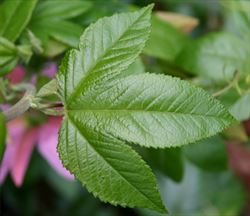
close-up of three-lobed leaf (Photo: Trevor James)

close-up of flower bud and coiled tendril (Photo: Trevor James)
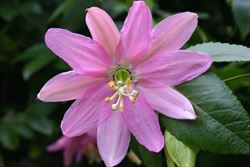
pale pink flower (Photo: Trevor James)
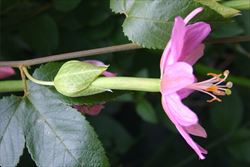
flower from side-on showing long floral tube and two basal bracts (Photo: Trevor James)
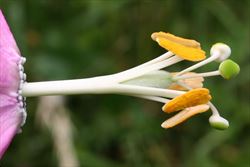
close-up of yellow stamens, hairy ovary and styles topped with green stigmas (Photo: Trevor James)
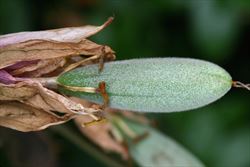
young fruit (Photo: Trevor James)
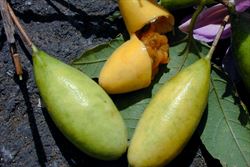
mature fruit with pulp and seeds (Photo: Forest and Kim Starr, USGS)

seedlings (Photo: Forest and Kim Starr, USGS)

the very similar Passiflora tripartita var. mollissima (Photo: Trevor James)
Scientific Name
Passiflora tarminiana Coppens & V.E. Barney
Synonyms
Passiflora mollissima (Kunth) L.H. Bailey (misapplied)
Family
Passifloraceae
Common Names
banana passion flower, banana passion fruit, banana passion vine, banana passionflower, banana passion-fruit, banana passionfruit, banana poka, passion-flower vine, pink banana passionfruit
Origin
Native to tropical South America (i.e. Bolivia, Colombia, Ecuador, Peru and Venezuela).
Cultivation
This species is cultivated, particularly in temperate regions, for its showy flowers as well as its edible fruit.
Naturalised Distribution
This species is becoming widely naturalised in south-eastern Australia (i.e. it is naturalised in the coastal districts of eastern New South Wales, in Tasmania, in southern Victoria and in south-eastern South Australia). Also sparingly naturalised in south-eastern Queensland.
Naturalised overseas in eastern Africa, Sri Lanka, the Philippines, Papua New Guinea, Hawaii, New Zealand and on La Réunion.
Habitat
A weed of watercourses (i.e. riparian areas), closed forests, forest margins, open woodlands, waste areas and plantation crops in temperate and occasionally also sub-tropical regions.
Habit
A vigorous climbing plant growing up to 20 m into the forest canopy, or scrambling over lower vegetation.
Distinguishing Features
- a vigorous climbing plant with and hairy younger stems.
- coiled tendrils are borne in the forks of its alternately arranged leaves.
- its leaves have three pointed lobes with toothed margins and softly hairy undersides.
- its large pale pink flowers (about 6 cm across) hang downwards and have a long greenish-coloured floral tube.
- its oval or slightly elongated fruit (7-14 cm long) turn yellow or pale orange when mature.
Stems and Leaves
Its younger stems are rounded (i.e. terete) and hairy (i.e. pubescent). Coiled tendrils are borne in the leaf forks (i.e. axils).
The alternately arranged leaves (7-16 cm long) are deeply three-lobed and borne on hairy stalks (i.e. pubescent petioles) 1.5-4 cm long. They have toothed (i.e. serrate) margins and the lobes are pointed (i.e. acuminate). Their upper surfaces are hairless or almost hairless (i.e. glabrous or sparsely pubescent), while their undersides are softly hairy (i.e. pubescent).
Flowers and Fruit
The large pale pink flowers (about 6 cm across and 9-10 cm long) are borne singly in the leaf forks on stalks (i.e. peduncles) 3-10 cm long. These flowers hang downwards (i.e. they are pendent) and at the base of the each flower are a pair of bracts (3-4 cm long and 2-3 cm wide) that can be mistaken for sepals. The five sepals and five petals are all very similar in size (4.5-6 cm long and 1.2-2.5 cm wide) and colour. Their bases are joined together, forming a very long and narrow greenish-coloured floral tube (i.e. hypanthium) 6-8 cm long and 7-10 mm wide. Each flower also has five stamens and a hairy ovary topped with three white styles ending in green stigmas. Flowering can occur throughout the year.
The fruit is an elongated or oval (i.e. ellipsoid) berry that turns from green to yellow or pale orange in colour as it matures. These fruit (7-14 cm long and 3.5-4.5 cm wide) are hairy (i.e. pubescent) when young and contain numerous seeds in an orange-coloured pulp. These seeds are reddish-brown when dry with a patterned surface texture (i.e. they are reticulate).
Reproduction and Dispersal
This species reproduces mainly by seed, which are dispersed by birds and other animals (e.g. pigs and foxes) that eat the fruit.
Environmental Impact
Banana passionfruit (Passiflora tarminiana) is regarded as an environmental weed in Victoria, Tasmania and New South Wales and as a potential environmental weed or "sleeper weed" in other parts of southern Australia.
Legislation
Not declared or considered noxious by any state government authorities.
Management
For information on the management of this species see the following resources:
- the Banana passionfruit page on the South Coast Weeds website at http://www.esc.nsw.gov.au/Weeds/index.asp.

